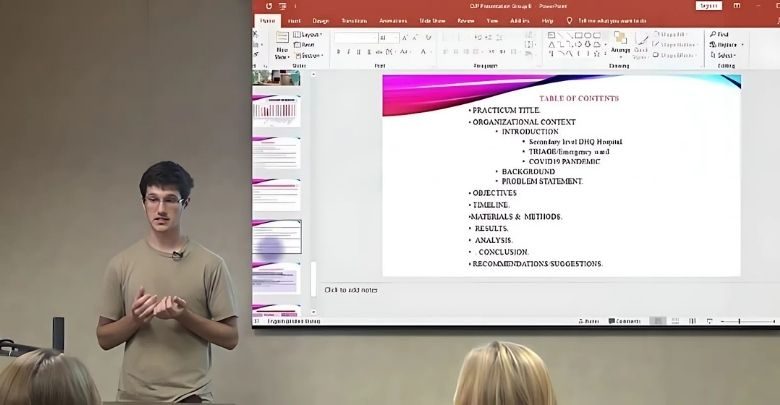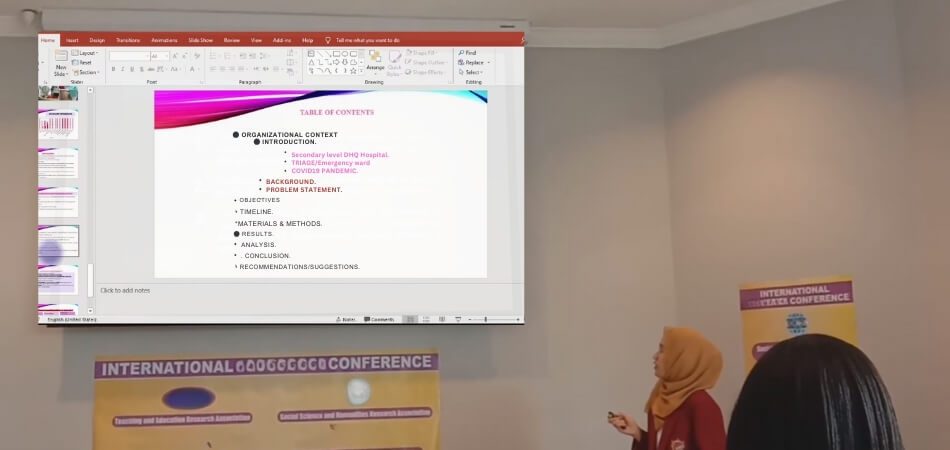In today’s date, presenting at a conference has become an essential skill, allowing individuals to communicate ideas, research, and innovations effectively. Mastering this skill not only opens up opportunities but also requires a thoughtful approach to engaging and connecting with an audience. Perhaps you’re now wondering how to present a PPT in a conference?
To deliver a successful presentation, start by knowing your audience’s interests and backgrounds to make your content relatable. Prepare a strong opening to capture attention, structure your slides clearly, and keep visual aids simple to avoid distractions. Practicing eye contact, pacing, and engaging with questions enhance your connection, making your presentation impactful.
Do you want to learn more about presenting at conferences? This article covers all essential techniques, from making a memorable flow to highlighting takeaways. Read on to discover how to make your next presentation truly stand out!
Why Should You Present Your PPT in a Conference?
An excellent opportunity to introduce your ideas to a larger audience is to present your PowerPoint at a conference. This visibility not only boosts your confidence but also improves your presentation skills in a professional environment. Additionally, conferences create perfect settings to receive helpful feedback that can significantly refine your work and ideas.
Another significant benefit of presenting at a conference is the opportunity to expand your professional network. Engaging with experts, professors, and industry professionals allows you to build relationships that may support your career growth. Such interactions can provide unique insights and encourage new research directions while introducing you to resources not easily found elsewhere.
When you present your PPT at a reliable conference, it reflects your commitment to academic or professional growth. This act signals to peers and experts that you take your work seriously and are open to learning. Moreover, this credibility can enhance your reputation, as presenting at a renowned event, such as conferences in Canada or other notable locations, demonstrates that your research or insights deserve attention.
How to Present a PPT in a Conference?
Clarity, self-assurance, and an audience connection are necessary when giving a presentation at a conference. An engaging start, well-organized content, and clear conclusions make your presentation memorable. Each section here will guide you toward a polished, effective delivery:
Know Your Audience
Effective communication is made possible by knowing the interests and knowledge of your audience. Adjusting your language and examples to their level creates a connection. Consider their backgrounds and expectations to make your content relevant. This approach not only engages them but also ensures your insights resonate well, making them more likely to absorb the information presented.
Start with a Strong Opening
Beginning with a strong opening captivates the audience and sets the tone for your presentation. Use a bold statement, surprising statistic, or personal story to grab attention. Establishing context here invites listeners into your topic. This initial engagement helps create an atmosphere of interest, encouraging the audience to invest their attention in your ideas.
Structure Your Content Clearly
Organizing your content into a clear structure enhances audience understanding and retention. Use headings, bullet points, and short phrases to break down complex ideas into digestible segments. A logical flow keeps listeners engaged as they follow your narrative. This clarity helps ensure that each point builds upon the previous one, reinforcing key concepts effectively.
Use Simple, Visual Elements
Visual elements significantly improve learning when used effectively. Keep your graphics simple, ensuring they directly support your main points without overwhelming the audience. Limit text on slides to essential ideas, allowing visuals to clarify and strengthen your message. This approach aids retention, helping the audience better absorb the information presented throughout your talk.
Maintain Eye Contact
Establishing and maintaining eye contact builds rapport and demonstrates your confidence. Connecting with different audience members throughout your presentation fosters a sense of engagement. This practice encourages listeners to focus on your message and feel included in the conversation. Regular eye contact also helps create a comfortable environment, enhancing the overall impact of your presentation.
Keep a Steady Pace
Maintaining a steady speaking pace helps your audience absorb information effectively. Avoid rushing through your content, as this can lead to confusion and disengagement. Pausing between key points gives listeners time to process and reflect. A controlled pace encourages clarity and ensures that everyone fully grasps each idea before moving on to the next.
Prepare for Questions
Anticipating questions demonstrates your readiness and strengthens audience engagement. Think ahead about potential queries related to your main ideas and prepare concise responses. Addressing questions with confidence shows your expertise and reinforces the material you’ve covered. This proactive approach helps maintain a smooth flow during your presentation, encouraging a more interactive experience.
End with a Strong Conclusion
A powerful conclusion reinforces your key messages and provides the audience with a clear takeaway. Summarizing your main points without excessive detail ensures clarity and emphasis. Finish with a thought-provoking remark or call to action, leaving a lasting impression. This final note helps solidify your talk’s impact and encourages further reflection on your topic.
By mastering these presentation techniques, you will enhance your confidence, improve clarity, and build stronger connections with your audience. These skills will ensure your presentation stands out, leaving a lasting impact in any conference setting.
What to Consider When Presenting PPT in a Conference?
Presenting a PPT at a conference requires thorough preparation, effective communication, and audience engagement. Balancing visual appeal with clear, concise delivery is essential for making a memorable impact on listeners. Here are some important considerations to keep in mind:
Set Clear Presentation Goals
Defining your presentation goals is key to a successful delivery. Having a specific purpose, whether to inform, inspire, or persuade, shapes the content and direction of your talk. This alignment helps each part of the presentation work together, supporting the overall message and ensuring relevance for your audience.
Acknowledge Timing and Flow
Managing timing and pacing maintains audience interest and engagement. When planning, you should account for each section’s length, keeping transitions smooth. Adjusting content flow and determining the number of slides required ensures a well-balanced presentation that avoids overwhelming or underwhelming attendees.
Choose Audience-Centric Language
Adjusting your language to suit your audience’s background and knowledge level enhances clarity. Avoiding overly technical terms or jargon helps you convey ideas more effectively. By ensuring your language is accessible, you promote better understanding and keep listeners engaged throughout the presentation.
Practice and Refine Delivery
By practicing the delivery, you can build your confidence and resolve any possible problems. This preparation improves pacing and transitions, making your presentation more effortless. Refining your speech and gestures before the event ensures a polished and professional impression that resonates with the audience.
Prepare for Technical Needs
Ensuring technical needs are met in advance avoids disruptions during the presentation. Checking equipment such as microphones, projectors, and connections minimizes last-minute issues. Being well-prepared with backup files or visuals keeps everything running smoothly, letting you focus on delivering your message.
A well-thought-out approach to presenting PPT at a conference strengthens your effectiveness and builds audience connection. Careful planning of content, pacing, and language all contribute to an impactful presentation experience for everyone involved.
How Can You Make Your PPT Stand Out in Conference?
It takes skillful techniques that grab the audience’s interest and keep them interested throughout a presentation to make it memorable in a conference setting. By blending concise content, visual appeal, and storytelling, you can significantly enhance your impact and leave a lasting impression.
Focus on Visual Simplicity
Using a visually simple design is crucial to keeping the audience focused on your key points. Avoid overly complex layouts, as they can distract rather than inform. Prioritize clean, concise slides with minimal text. This approach makes your content clearer and easier for the audience to follow, enhancing overall comprehension.
Begin with a Strong Opening Statement
A compelling opening statement draws listeners in and sets the tone for your presentation. Starting with a surprising fact, relatable story, or bold statistic piques curiosity. Establishing relevance early on invites the audience to engage, making it easier to maintain their interest throughout your talk and create a strong connection.
Structure Content Logically
Organizing your presentation with a clear structure aids comprehension and ensures an effective flow. Break down complex information into sections, using headings and sub-points for clarity. This logical approach helps guide the audience smoothly from one topic to the next, reducing confusion and enhancing retention of key messages.
Utilize Consistent Engagement Techniques
Using consistent engagement techniques—like asking rhetorical questions, sharing anecdotes, or interacting briefly—keeps listeners involved. Incorporating visual cues or dynamic transitions also captures attention. Balancing these techniques with your main content ensures audience interest remains steady without overwhelming them, promoting a more interactive and memorable experience.
Emphasize Memorable Takeaways
By focusing on memorable takeaways, you can make sure that your audience will remember your key ideas long after the presentation is over. Summarize key ideas toward the end, connecting them to your core message. Offer practical applications or a thought-provoking statement, leaving the audience with a clear sense of purpose and a lasting impression of your presentation.
Incorporating these strategies will help your presentation make a lasting impact in any conference setting. Moreover, improving clarity and engagement by carefully applying the 10 20 30 rule in presentations ensures your message resonates effectively with the audience.
Tips for Practicing and Perfecting Your PPT Delivery
A strong presentation can leave a lasting impression on your audience. To achieve this, practicing your delivery is essential for building confidence and ensuring clarity. Here are some tips to help you practice and perfect your PPT delivery.
- Know Your Material: Familiarize yourself with the content of your presentation. Understanding your material deeply will allow you to speak more naturally and confidently, engaging your audience effectively.
- Rehearse Aloud: Practicing your presentation out loud helps you identify areas that need improvement. This technique also allows you to adjust your pacing and refine your choice of words for better clarity.
- Use a Timer: Timing your presentation can ensure that you stay within your allotted time. It also helps you practice pacing, allowing for pauses where necessary to emphasize key points and enhance audience understanding.
- Record Yourself: Recording your practice sessions can provide valuable insights. Watching the playback helps you notice your body language, voice modulation, and areas for improvement that you might overlook while presenting.
- Get Feedback: Presenting to friends or colleagues can provide constructive criticism. Others can offer perspectives on what works well and what might need adjustments, helping you refine your delivery style.
- Practice with Visual Aids: Familiarize yourself with your slides and any visual aids you plan to use. Practicing with these tools helps you integrate them seamlessly into your presentation, making it more engaging and informative.
- Stay Relaxed: Managing anxiety is crucial for effective delivery. Find relaxation techniques that work for you, such as deep breathing or visualization, to help calm your nerves before and during your presentation.
Practicing and perfecting your PPT delivery can significantly enhance your effectiveness as a speaker. Consistent practice, combined with thoughtful adjustments based on feedback, can lead to a polished and engaging presentation that resonates with your audience.
Frequently Asked Questions
Whether you’re a first-time presenter or aiming to improve your delivery, these FAQs provide practical insights into making your conference presentation stand out. From managing presentation nerves to handling unexpected issues, these questions address key areas to help you succeed.
How Do I Manage Presentation Nerves?
Taking deep breaths and practicing positive visualization can help calm pre-presentation nerves. Focus on the message you want to deliver rather than on potential mistakes. Practicing your content beforehand and being familiar with your slides will also help increase confidence, making it easier to stay calm and composed.
What Should I Do If I Forget a Key Point?
If you forget a point, take a brief pause to regroup. Summarize the last slide’s main ideas to give yourself time to recall the next. Practicing transitions beforehand can minimize this issue. If needed, move on confidently; the audience may not notice, and you can revisit the point later.
How Do I Handle Technical Issues During My Presentation?
If technical issues arise, stay calm and reassure the audience as you troubleshoot. Have a backup, such as printed slides or a flash drive, in case technology fails. Familiarizing yourself with the equipment ahead of time can help prevent delays and ensure you’re prepared to handle unexpected issues.
How Can I Keep My Audience Engaged Throughout?
Maintaining engagement involves more than just speaking. Use varied tones, incorporate personal anecdotes, and periodically make eye contact with audience members. Brief interactive moments, like asking for a quick opinion, can also refresh focus. Keeping slides visually appealing and concise also helps the audience stay interested.
What Should I Do When My Presentation Ends?
After concluding, open the floor for questions to encourage further engagement. Summarize key points one last time if possible, giving the audience a lasting takeaway. Thank them for their attention, and provide a way for them to follow up with you if they have additional questions or feedback later.
End Note
Presenting at a conference is a valuable opportunity to share your ideas and connect with a wider audience. The skills you develop through this experience can enhance your professional growth and grow your confidence in public speaking. Embracing this chance will serve you well in future work.
To effectively address the question of how to present a PPT in a conference, focus on knowing your audience and delivering a well-structured presentation. Start strong, engage your listeners, and keep your visuals clear and simple. Practicing thoroughly will prepare you for unexpected challenges, making your presentation smoother and more impactful.
As you prepare for your next presentation, remember to stay calm, maintain eye contact, and encourage audience interaction. Make use of engaging visuals and rehearse your delivery to increase your effectiveness. Best of luck with your presentation—you have the potential to leave a lasting impression!








